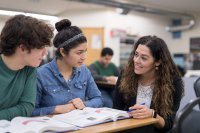Learning to See Students’ Deficits as Strengths
A teacher works to see the upsides in students’ learning difficulties—and uses them to help all students succeed.
Your content has been saved!
Go to My Saved Content.Nineteen years ago, I taught two Latina girls in one of my eighth-grade English classes. Julia and Lourdes (these aren’t their real names) always talked to each other in the back of the classroom. I used proximity and the dad stare, and frequently asked them to pay attention, but nothing worked. I was at my wits’ end. Finally, I pulled them aside after class and tersely said, “I’m constantly at you about talking. Would you please tell me what’s going on?”
Julia said, “You talk really fast.” Lourdes added, “We’re making sure we understand.”
The girls told me they were trying to translate everything that was said in class into Spanish in order to comprehend it, and then formulate their responses. Julia actually drafted her writing assignments in Spanish to get her thoughts out and then translated them into English to submit to me. I was amazed and astonished by their grit and ingenuity.
Zaretta Hammond, the author of Culturally Responsive Teaching and the Brain, describes culturally responsive teaching as knowing your kids well and being able to leverage whatever they come to you with as a strength in the classroom to help them learn. Instead, I had fallen back on stereotypes and biases, which led me to deficit thinking. Before I talked to Julia and Lourdes, I viewed English language learners as having a problem that needed fixing. Instead, those girls’ use of Spanish was a strength I could capitalize on to help them learn English.
Find Ways to Create Time to Think
I realized that instead of discouraging conversations between these two students, I needed to create opportunities for them to engage in discourse so that they could check their understanding.
I restructured the class to create more discourse opportunities for all students. During lectures, I built in time for think-pair-share, where students first think of a response, discuss it with a partner or small group, and then share out to the whole class. This gives students time to activate prior knowledge and to think about their responses. It also deepens their comprehension by exposing them to their peers’ ideas. And when I incorporated think-pair-share into the regular class routine, Julia and Lourdes’s talking went from being a problem to a strength.
Be Open to Listening to Your Students’ Needs
After talking to Julia and Lourdes, I realized that English language learners—who made up 15 to 30 percent of my class on any given year—often could not understand me. I began paying attention to the cadence of my voice and slowed down so my students could better understand me. I used wait time—giving students time to think before I called on them to answer a question—so they could process their thoughts. And I began asking students to explain my instructions to the class to ensure that everyone understood them.
I also worked out a system with Julia and Lourdes so that they could let me know when they needed help. They could raise their hand at any point during a lesson and say, “Slow down, please.”
I extended this practice to the entire class; students not only had permission to interrupt me if they needed clarification but were expected to. Students who felt uncomfortable speaking up in class came up with personal signals they could use with me, including a finger wave, a raised eyebrow, and a traffic system with colored index cards—red to let me know I needed to stop, yellow to ask me to slow down, and green to indicate I could move on. One student who preferred not to speak texted me during class when she had a question.
Leverage Your Students’ Identities to Support Learning
Many years later, as a veteran teacher, I had a high-functioning autistic boy in my English 10 class. Because of his limited social skills, students didn’t want to work with him, and he didn’t like presenting in front of his peers. At first, it was challenging, but eventually he became someone his peers requested for collaborative projects because he had the ability to recall details from research. His academic ability helped bridge social divides between him and his classmates, and I also approached a popular football player to invite the autistic student to contribute his ideas during discussions and help give him a voice.
My autistic student was also great at coaching other students in collaborative learning because of his ability to read closely and point out details that others missed. By capitalizing on his strengths, he was able to show his worth and create situations where he could best show his understanding. Instead of having him present to the class, I measured his speaking standard and knowledge by listening to him coach other students. By the end of the year, he did deliver a speech, but I modified the assignment—he chose five people he felt comfortable with and delivered the speech to them during his lunch period.
Seeing Your Students’ Strengths
Students don’t need to be fixed. They need teachers who make data-informed instructional decisions to match best practices to students’ needs. They need teachers who offer high support while holding them to high expectations by implementing appropriate scaffolds and rolling them back as the students demonstrate greater proficiency. And they need teachers who acknowledge their mistakes and engage in ongoing professional learning.
Instead of thinking of my students’ diverse identities as problems to fix, through professional development I have come to understand their differences are strengths. My English language learners speak two languages, and my autistic student may have an incredibly analytical mind. All of my students possess various seen and unseen abilities. After years of practice and self-reflection, I have come to realize that if anything needs to be fixed, it is my bias.
